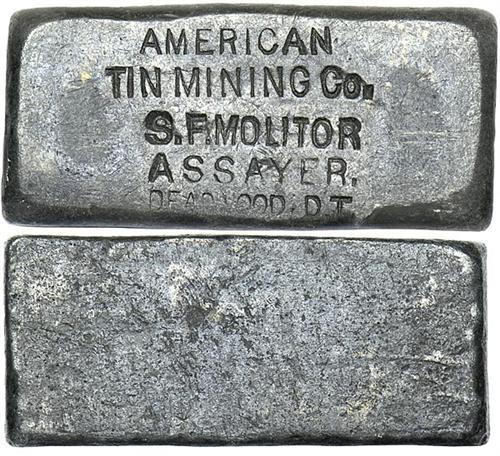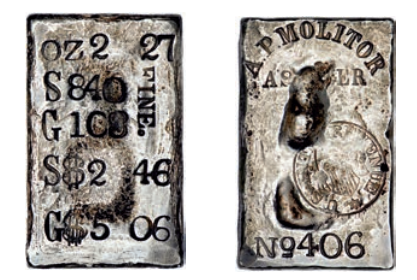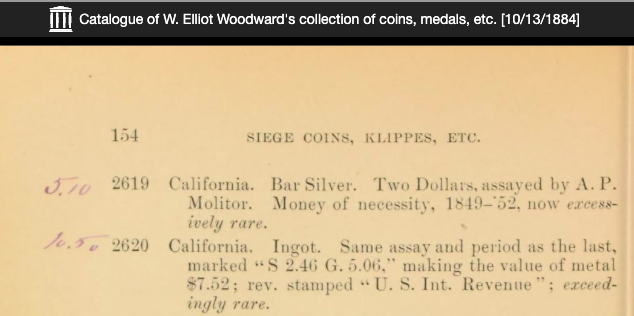AGOSTHON P. MOLITOR
STEPHEN F. MOLITOR
San Francisco, California, San Diego, California, Deadwood, Dakota Territory
Agosthon Molitor began his work as an assayer in California in 1851 in partnership with fellow Hungarians Samuel Wass and Charles Uznay in the firm of Wass, Molitor and Company, one of the most important private coinage ventures in the west. He left California in 1856. His story as an independent assayer begins on his return to that state in 1859. Stephen Molitor, his son, had a checkered career through many western mining camps and even into Canada, working as a tramp assayer (as Fred Holabird so described him) in the 1860s and 1870s. By 1884-5 he was located in Tinton, South Dakota (then Dakota Territory) and had joined with others to form the American Tin Mining Company. Molitor was its assayer. However, the tin boom quickly faded and by the beginning of 1893 tin was played out and with it, Stephen Molitor’s recorded career as an assayer.
4.02 oz A. P. Molitor Silver Ingot. ca. 1863-1867, San Francisco.


The top side is imprinted: OZ 4 02 / SILVER 898 $4.66 / GOLD 069 $5 73. A partial Internal Revenue stamp (OIR) is seen on the right portion of the top side. One of the long, narrow sides reads No 804, while the other long, narrow side has the curved A.P. Molitor company stamp.
This small 4.02 ounce silver ingot has high gold fineness for a silver dore’ bar, possibly indicating or suggesting an earlier date such as 1863, the year of the Gould & Curry bonanza on the Comstock in Virginia City. It cannot predate 1863 because of the Internal Revenue bullion punch on the reverse. The earlier mined Comstock ores had a higher percentage of gold, which dropped radically with the depth of mining. The ingot is probably not from Molitor’s 1865 foray to Julian, California, the San Diego County gold district where he briefly set up shop in 1865 before moving back to San Francisco.
The bullion gang punch of A. P. Molitor is on the side of the ingot in an arch, applied in the same manner as the small Kellogg & Humbert S.S. Central America ingots and the two known silver Kellogg & Hewston ingots. It is identical in style and approximate size to the A. P. Molitor bullion punch seen in the famous Fricot Nugget photograph taken for the 1867 International Paris Exposition by San Francisco photographer Carleton Watkins (and others). The rest of the ingot is quite crude, and it lacks an assay chip, which is not always present on small ingots. Its genuineness is unquestioned, since the bullion punch visible in the Fricot photograph was not available or known until recently.
From The Kagin Reference Collection of Frontier Ingots.
[08/2006] https://coins.ha.com/itm/ingots/a-p-molitor-silver-ingot-ca-1863-1867-san-francisco-the-top-side-is-imprinted-oz-4-02-silver-898-466-gold-069-/a/414-2579.s ($27,600)
Stephen F. Molitor, Assayer. American Tin Mining Company. Deadwood, Dakota Territory.


For a detailed review of Stephen Molitor’s tin ingots, see the following page:
Read: https://rareingot.com/stephen-f-molitor-assayer/
2.27 oz Augustus P. Molitor, Assayer. San Francisco, California. Silver &
gold assay ingot no. 406.

Overall appearance of Very Fine or so, actually essentially Uncirculated. A very unprepossessing thin ingot with rough surfaces, poorly finished edges, deep cooling fissures on the back that were overpunched regardless. One has the impression that this was not meant for general public consumption but was intended for a more private audience, perhaps as a test ingot or a souvenir of a new business venture. Light silver gray in color with some flash on the smoother parts of the surfaces. Face fairly well stamped but back quite poor, ASSAYER only partial, OIR stamp incompletely punched in. This bar made its first appearance at public auction within a couple of decades of when it was made. In the intervening century and more, one of the longest pedigree chains known for any ingot, it has had only four recorded owners.
Two other silver A.P. Molitor bars are known to the cataloguer:
(1) HolabirdKagin Fall 2006 FPL, item 52, a $5.73 bar offered at $75,000 and
(2) a piece described as a $2 bar by Woodward in the same sale the present
Garrett-Ford bar was offered in. Its whereabouts are presently untraced.
This present ingot was illustrated in the cataloguer’s 1999 AJN II article
on ingots.
- Face: OZ 2 27 / S840 FINE.[vertically at right between this and next] / G108 / S$2 .46 / G$5 06.
- Back: A.P. MOLITOR / ASSAYER / OIR stamp / No. 406.
- Top side: blank.
- Bottom side: blank.
- Left side: blank.
- Right side: blank.
- Dimensions: 52.3 x 32.2 x 4.3 mm.
- Current weight: 70.72 gms.
Ex William E. Woodward’s sale of October 13, 1884, lot 2620; Georg F. Ulex Collection (Lyman Low, July, 1902, lot 536); Garrett Collection (Bowers & Ruddy, March 25, 1981, lot 1944).
STOLEN
Shortly before this catalogue went to press, this and four other ingots from the Ford Collection were stolen during transit. Since they had already been photographed and described, Stack’s decided to retain their lot descriptions in this catalog in order to preserve their numismatic evidence for future researchers and to aid in their hoped recovery.
From Catalogue of W. Elliot Woodward’s collection of coins, medals, etc. [10/13/1884]

The Two Dollars Ingot and a 2.27 oz Molitor Ingot were referenced and auctioned 10/13/1884 by Woodward.
The second ingot in the same sale was marked “S 2.46 G. 5.06,” making the value of metal $7.52; rev. stamped “U. S. Int. Revenue”; listed as exceedingly rare. This is the ingot that was listed as stolen above prior to the Ford sale in 2007.
One wonders if either of these two will ever turn up again or if they are lost forever.
See: https://nnp.wustl.edu/library/auctionlots?AucCoId=29&AuctionId=511246
